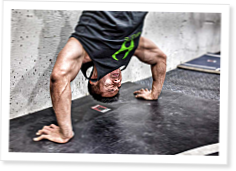
Identifying and correcting range-of-motion, stability and technique issues will pay dividends when athletes are upside down.
Many exercises commonly used in CrossFit are also frequently used by athletes participating in other sports. However, the handstand—fundamental to gymnastics—is a rarely employed training tool in other sports but an essential part of CrossFit.
The handstand requires considerable amounts of both joint mobility and stability if it is to be performed with optimal technique. The basic handstand distinguishes itself from other skills because it provides an unconventional way of strengthening the shoulder complex. The shoulder becomes the main joint providing stability to the body. This inverted position helps develop “shoulders strong as hips,” increasing shoulder strength in ways other skills or weight-training exercises cannot, according to CrossFit Founder and CEO Greg Glassman in the article “Handstands.”
Because of the inverted position, increased demands are placed on the wrists, elbows and shoulders, as these three joints bear the body’s weight. An analysis of the joints and muscles involved in a handstand can help identify limitations that must be addressed to perfect this skill and improve athleticism.
No comments:
Post a Comment